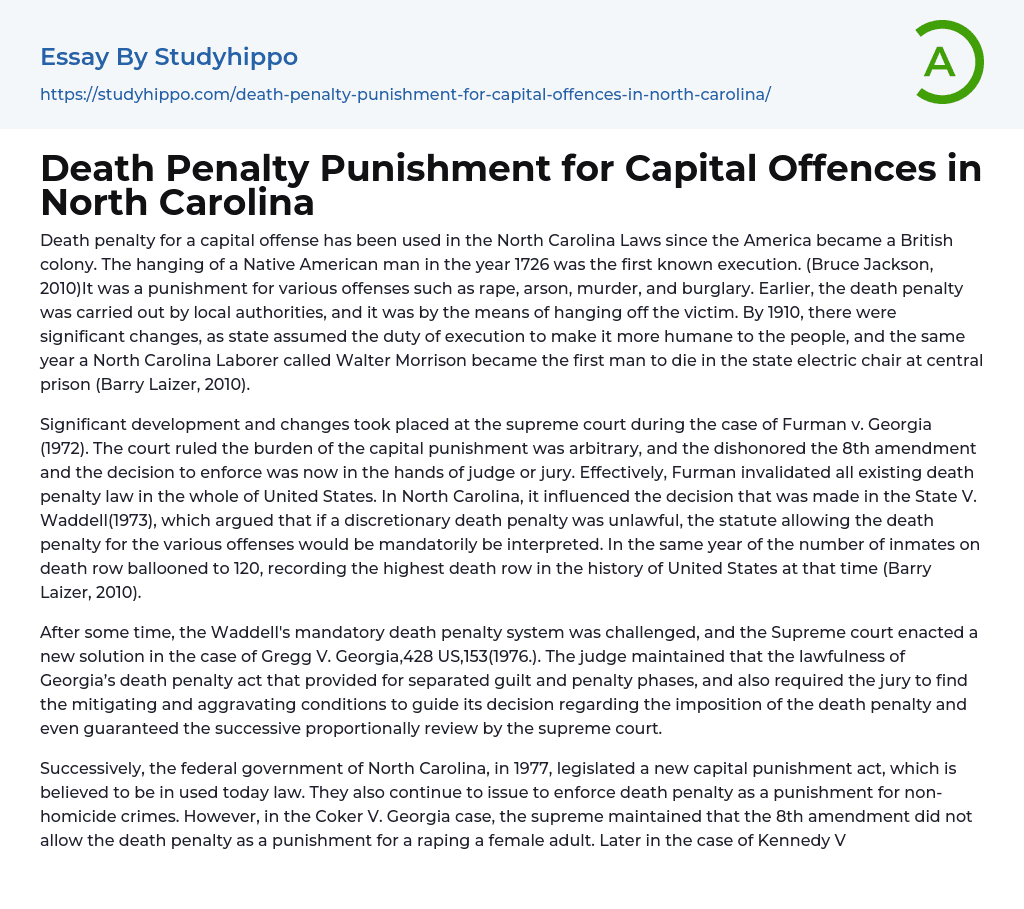

Death Penalty Punishment for Capital Offences in North Carolina Essay Example
Death penalty for a capital offense has been used in the North Carolina Laws since the America became a British colony. The hanging of a Native American man in the year 1726 was the first known execution. (Bruce Jackson, 2010)It was a punishment for various offenses such as rape, arson, murder, and burglary. Earlier, the death penalty was carried out by local authorities, and it was by the means of hanging off the victim. By 1910, there were significant changes, as state assumed the duty of execution to make it more humane to the people, and the same year a North Carolina Laborer called Walter Morrison became the first man to die in the state electric chair at central prison (Barry Laizer, 2010).
Significant development and changes took placed at the supreme court during the case of Furman v. Georgia (1972)
.... The court ruled the burden of the capital punishment was arbitrary, and the dishonored the 8th amendment and the decision to enforce was now in the hands of judge or jury. Effectively, Furman invalidated all existing death penalty law in the whole of United States. In North Carolina, it influenced the decision that was made in the State V. Waddell(1973), which argued that if a discretionary death penalty was unlawful, the statute allowing the death penalty for the various offenses would be mandatorily be interpreted. In the same year of the number of inmates on death row ballooned to 120, recording the highest death row in the history of United States at that time (Barry Laizer, 2010).
After some time, the Waddell's mandatory death penalty system was challenged, and the Supreme court enacted a new solutio
in the case of Gregg V. Georgia,428 US,153(1976.). The judge maintained that the lawfulness of Georgia’s death penalty act that provided for separated guilt and penalty phases, and also required the jury to find the mitigating and aggravating conditions to guide its decision regarding the imposition of the death penalty and even guaranteed the successive proportionally review by the supreme court.
Successively, the federal government of North Carolina, in 1977, legislated a new capital punishment act, which is believed to be in used today law. They also continue to issue to enforce death penalty as a punishment for non-homicide crimes. However, in the Coker V. Georgia case, the supreme maintained that the 8th amendment did not allow the death penalty as a punishment for a raping a female adult. Later in the case of Kennedy V. Louisiana, 554 U.S.407 (2008), the supreme held that the death penalty will not be enforced on a victim of a child rapist. In 1979, all the sexual assault laws were reviewed by the General Assembly.(Bruce Jackson, 2010)
Many decisions affecting capital punishment have been changed in the following subsequent years. This included the 1980s and 1990s court ruling of Enmund v Florida,458.US.782. (1982) A case, it prohibited the capital punishment as punishment to individual victims who are only guilty as an aid in a murder case. In 1994, North Carolina changed structured sentencing that made life incarceration without parole an alternative to the death penalty and 1998; the same government proposed lethal injection method as a way of execution (Barry Laizer, 2010).
According to statistics recently, there is a reduction in the number of death sentences, capital trial and executions as compared
to historical age. The number of crime case has drastically decreased, which I think is a good indication. Only one person to be executed on the in the northern Carolina put off death on 2006, of which that in a good sign of sanity. A lot of voices have been echoed concerning the human nature the death sentences as a capital punishment. Former supreme chief justice of Florida Gerald Kogan and Texas Governor Mark White, recently criticized a passed law of North Carolina that imposes secrecy on uses of lethal injection drugs and that also removed the procedures public review and comment. The Carolina Newspaper also seconded this critique. As I per thinking, the Supreme Court should find a means to enact laws that can reduce all capital charges to life sentences to serve as an example to rest of the world.
References
- Barry Laizer, D. M. (2010). Death penalty cases: Leading US supreme Courtc cases on capital punshment. chicago: Elsevier publisher.
- Bruce Jackson, D. C. (2010). In this Timeless Time: Living and Dying on Death Row in America. North carolina, unites states of America: University of North Carolina Press.
- Affirmative Action essays
- Assisted Suicide essays
- Capital Punishment essays
- Censorship essays
- Child Labour essays
- Child Protection essays
- Civil Rights essays
- Corporal Punishment essays
- Death Penalty essays
- Empowerment essays
- Euthanasia essays
- Gay Marriage essays
- Gun Control essays
- Human Trafficking essays
- Police Brutality essays
- Privacy essays
- Sex Trafficking essays
- Speech essays
- Automobile essays
- Bus essays
- Civil engineering essays
- Cycling essays
- Electric Car essays
- Genetic Engineering essays
- Hybrid essays
- Innovation essays
- Internal Combustion Engine essays
- Invention essays
- Mechanical Engineering essays
- Mechanics essays
- Software Engineering essays
- Telephone essays
- Death Penalty Pros And Cons essays
- Is The Death Penalty Effective essays



